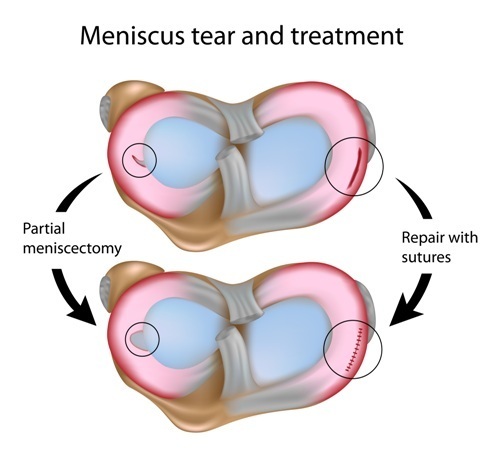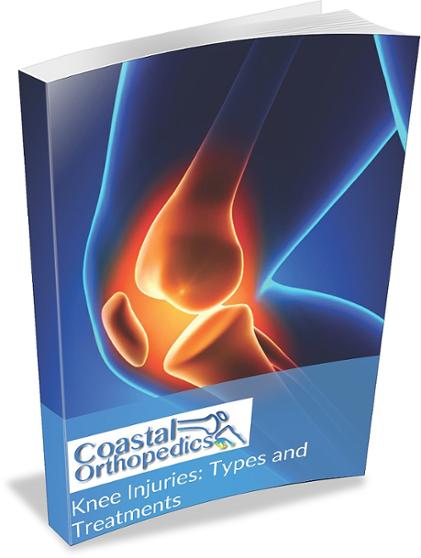What Is Meniscus Repair Surgery? (Reasons, Procedure and Recovery)
May 5th, 2016 | 4 min. read


Meniscus repair is a knee surgery that repairs a torn piece of cartilage inside the joint. Meniscus tears are common knee injuries, especially among athletes. How do you know if you have a torn meniscus — and if surgery is required to fix it?
meniscus tears: Causes & symptoms
What is the meniscus?
A meniscus is a c-shaped piece of cartilage that functions as a shock absorber between the bones of the knee. Each knee has two menisci, a medial meniscus (in the inner side of the knee) and lateral meniscus (in the outer side of the knee).
The primary job of the menisci is to absorb pressure and distribute your body weight. Menisci also protect your leg bones from rubbing together, which can lead to osteoarthritis.
How meniscus injuries happen
Meniscus tears are often caused by sudden twisting motions. Sports injuries are the most common causes of these, but anyone at any age can injure their meniscus.
People sometimes tear their knee cartilage doing the following:
- Climbing stairs or hills
- Hyper-flexing (bending the knee too far)
- Squatting (especially while lifting a heavy weight)
- Walking on an uneven surface (like a poorly paved sidewalk or rough terrain)

Risk factors for meniscus tears
You're more at risk for an injury to the meniscus if you meet the following criteria:
- You're over age 30. Risk of meniscus injuries increases as you age, as the cartilage wears out.
- You play a sport that involves pivoting (e.g., basketball, golf, tennis).
- You play contact sports (e.g., football, hockey, rugby).
- You have a degenerative condition like osteoarthritis.
Symptoms of meniscus tears
If you experience any of the following in your knee, you may have torn your meniscus:
- buckling or "giving way"
- inability to straighten the knee (due to an increase in fluid around the injury)
- pain
- popping
- swelling
Keep in mind, many meniscus tears are small and may not present as acute injuries. You may find, instead, that you notice your knee behaving differently over time.
Subtler, intermittent symptoms may include:
- Buckling or giving way of the knee
- Locking — your knee gets stuck in a flexed position and cannot straighten or bend
- Popping, especially when climbing up or down stairs
- Pain when running or walking long distances
- Occasional tightness of the joint
reasons to get meniscus repair surgery
In some cases, you can treat the pain and discomfort of a meniscus tear with RICE therapy (rest, ice, compression, and elevation) or NICE therapy (non-steroidal anti-inflammatory drugs, like ibuprofen or naproxen), ice, compression, and elevation).
However, if you suspect you've injured your meniscus, you should see a doctor. Many meniscus injuries occur in the inner two-thirds of the meniscus, in the "white" zone where blood supply is not as rich. Without nutrients, these injuries seldom heal on their own.
Left untreated, a damaged meniscus can lead to other problems in your knee. Loose meniscus cartilage may move around inside your joint, leading to locking or popping of the knee and knee instability. A chronically injured meniscus can also lead to arthritis.
MENISCUS repair procedureS
Arthroscopic meniscus repair (meniscus repair vs. meniscectomy)
Your orthopedic surgeon may recommend minimally invasive knee arthroscopy: the use of an arthroscope (a tube with a camera attached to it) to look inside the knee and diagnose and repair your injury.
Meniscus repair arthroscopy usually proceeds as follows:
- After administering anesthesia and prepping your knee, your surgeon will use a scope to look inside the joint and determine whether the tear can be repaired or if you will need a partial meniscectomy (removal of the damaged part of the meniscus).
- If your meniscus tear can be repaired, the surgeon will suture the torn edges together. This technique works in approximately 10% of all cases. Surgeons usually prefer to perform repairs rather than meniscectomies because preserving the meniscus protects your knees from arthritis in the future. However, because the torn ends of cartilage must heal back together, recovering from this surgery can take longer.
Meniscus repair may work for you if:
- meniscus tissue is in good condition (aside from the injury, of course)
- tears run vertically through the meniscus
- tears are small and on the outer edges of the meniscus, in the "red zone" where the blood supply is rich (these are called peripheral menisco-capsular tears)
- If your tear cannot be repaired (true in an estimated 90% of cases), the surgeon will perform a partial meniscectomy, trimming away the damaged parts of the meniscus and leaving the healthy tissue intact. Patients who undergo this surgery often progress faster than those who receive sutures.
Partial meniscectomy is preferred for:
- flap tears (where a flap of the meniscus is torn away)
- tears that run horizonally through the meniscus
- tears that run through the "white zone," of the meniscus, where the blood supply is limited and injuries can't heal well on their own

- Less commonly, if the damage to the knee is more extensive, a full meniscectomy (removal of the entire meniscus) may relieve all symptoms. However, most active people prefer to keep as much of their meniscus intact as possible so they can continue to participate in sports and other activities. Removing the meniscus means removing the cushion between the knee bones, which can hasten knee degeneration.
- In cases of serious damage, bone degeneration, or multiple knee problems, a total knee replacement surgery may be recommended.
MENISCUS REPAIR recovery
Recovery time
If using arthroscopic techniques, meniscus surgery repair takes about one hour.
Post-surgery, recovery from meniscal repair takes from a few days to six weeks or even months, depending on the individual.
Many people are able to get off crutches in a day, but others may need to keep the weight off their knees for a longer period of time. You may need to walk with crutches and/or wear a brace until your knee heals.
Remember that everyone is different. No two people heal at the exact same speed. Your recovery time may be faster or slower depending on your age, weight, general health, lifestyle, and other factors (including how well you adhere to your surgeon's post-surgical recovery instructions!).
If your surgeon finds evidence of arthritis in other areas of your knee, your recovery may progress more slowly, with more discomfort and pain. To get relief from arthritis pain, some people opt to wear a compression sleeve during recovery.
Rehab and physical therapy
Most surgeons will recommend an at-home exercise regimen to help stimulate healing and get back to your normal activities. How much you do will depend on your general health and any underlying conditions you may have.
In some cases — for example, if you need to return to athletics quickly — physical therapy or sports medicine at a rehabilitation center may be recommended. If you are relatively young and in good shape, you may be able to return to running and walking after meniscus repair within a few weeks.
Pain after meniscus repair
For most patients, the pain after arthroscopic surgery is minimal and can be handled by taking over-the-counter pain NSAIDs like ibuprofen or naproxen.
WHEN TO CONSULT AN ORTHOPEDIC SURGEON
If you think you have a torn meniscus, give Coastal Orthopedics located in Corpus Christi, TX a call. Our orthopedic specialists can examine you, assess your condition, and discuss whether surgical meniscus repair may be an option for you. Telephone: 361.994.1166.
Article written by: Rob Williams, MD
Download the FREE 44 page eBook on Knee Injuries below:
Dr. Williams has been practicing orthopedic surgery in Corpus Christi since 1998. After graduating from Texas Tech hereceived his medical degree from the University of Texas at San Antonio. At the prestigious Campbell Clinic located at the University of Tennessee, Dr. Williams completed not only an Orthopedic Surgery Residency, but an additional year of Fellowship Training in Spine Surgery. Dr. Williams is dedicated to creating an excellent patient experience in the office or in the surgery suite.
Topics:


